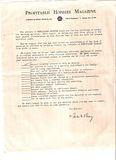___________________________________________
Mr. Theodore M. O'Leary, editor
Profitable Hobbies
24th and Burlington
Kansas City, Mo.
Dear Sir:
Enclosed is an article written for your consideration. I hope you may find it suited to your needs. If you find the material interesting but my style unsatisfactory, I will be glad to alter it to suit you.
I will look forward to hearing from you.
Sincerely,
/s/
Florence D. Brown
encl.
___________________________________________
A continuous supply of egg shells, a steady hand, and patience are the requirement for success in the fashioning of flow pictures for framing, the hobby of W.K. Stussy, of Copiague, Long Island, New York.
Mr. Stussy, who makes no claim to being an artist, has sold, for ten dollars and more, pictures of pansies, daisies, rosebuds, dogwoods, cosmos and poppies, modeled after pictures in seed catalogs.
His procedure is this: first he removes the membrane from the inside of the egg shell. This is done by moistening it and rolling it off with the fingers. Then, after examining the shell by holding it up to the light to be sure it is not cracked, he holds the shell between the thumb and forefinger of one hand, and with an ordinary pair of eyebrow tweezers, he nips tiny pieces from the edges of the shell until he has the shape desired.
When he has the required number of petals for the flower he has selected to make, he fastens them to a piece of cardboard with moisture-proof rubber cement. He places the rounded part of the shell up or down, depending on the shape of the flower. If it is a pansy, he places it down; a rosebud, up, and so on.
For the stems, Mr. Stussy uses green packing cord. He makes vases from egg shells which he has ground with a spoon in a cup and strained through a coffee strainer. The straining is done so that the particles will be of uniform size. Before placing the ground shell on the cardboard, he outlines the shape of the vase and puts colorless nail polish, which also is moisture proof, in the space, a small amount at a time because it dries quickly. The ground shell must be applied while the polish is wet in order for it to stay in place.
When the flow is complete, Mr. Stussy tints it with water colors, taking care to apply very little pressure with a camel's hair brush. He learned from experience that too much pressure will snap the petals. He uses an orangewood stick notched at one end to mark veins on the leaves.
The complete picture is then placed in a wooden shadow frame, which Mr. Stussy makes himself, of a size suitable for the flowers represented.
The time consumed in thus fashioning three pansies and two rosebuds with thorns and leaves, and a vase and shadow frame, is about about ten to twelve hours. Th quantity of shells used may vary with the artist. Mr Stussy used 42 shells in fashioning one petal before it suited him.
When Mr. Stussy started his hobby a few years ago, he used the shells of any eggs, but after considerable experimenting, he found that the removal of the membrane inside the shell was simpler when the egg had been hard boiled. His supply of such shells comes from his neighbors and friends who are glad to find a use for them, and from a nearby restaurant where baskets full are saved each week for him.
Mr. Stussy came upon his idea when he saw an oil painting which included some actual pussywillow branches, a part of some flowers which were flat, and some few egg shells used to give a relief effect. He warns the beginner that only flowers with one curve can be made. Flowers with two curves are not adaptable because although shells break readily, they will not bend.
Mr. Stussy puts his creations under glass in their shadow frames, because otherwise, he says, he would be repeatedly called upon to repair flowers damaged by the fingers of admirers who find them so lifelike that they want to touch.
###



No comments:
Post a Comment